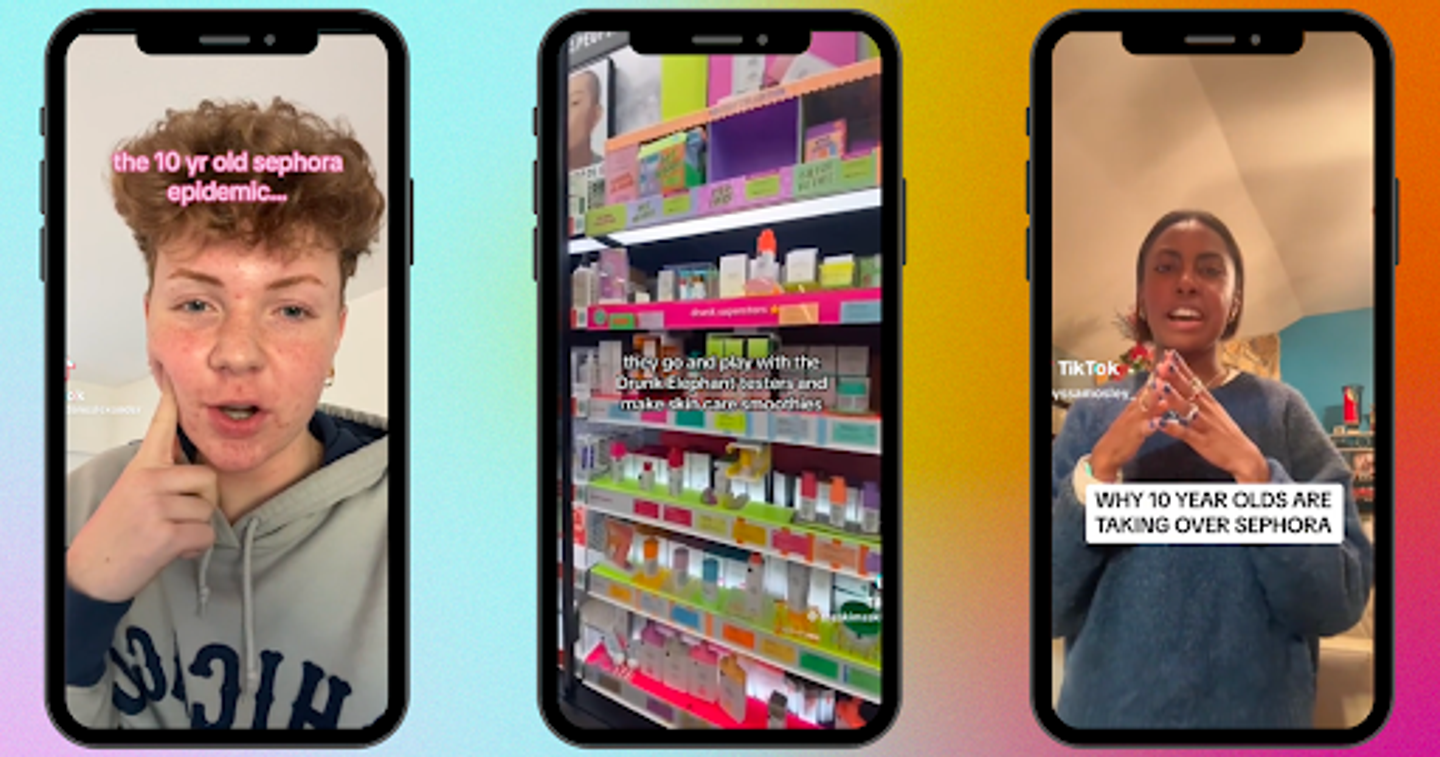
Avani Johnson
It’s easier to blame a 10-year-old than it is to blame ourselves for marketing malpractice.
Image: @itsdanealexander / @theskimaskbarbie / @meganlacey19 via HerCampus
In recent weeks, reporters, moms, and fellow Sephora shoppers have gone online to express bewilderment and straight-up ire at tween girls taking over the cosmetics stores in search of the latest and greatest skincare and beauty fads. What started with an off-hand TikTok from a micro-influencer asking, “Has anyone else noticed that every time you go into Sephora, now it’s just all little girls?” has become a mainstream media phenomenon.
Follow-up TikToks validating the observation quickly spiraled into morning segments on the Today Show and Good Morning America, and then articles in The Wall Street Journal. More than a month after the initial TikTok, social media users continue to profess a desire for a safe haven from these rude tweens (though one employee said, “they’re not rude, they’re just acting like 10-year-olds”). Psychologists continue to caution parents, and the blame game roils on.
Despite it all, the tweens themselves continue to shop unabashedly. Why? Because they’ve been sold a lie (and lifestyle) that’s too addicting to give up.
As one 11-year-old Sophie told The Cut, “There’s so much pressure to look perfect. Whenever I see a Sephora, I walk in.”
The lies sold to young girls.
Girls, on average, begin wearing makeup as young as age 6 – reporting ‘feeling ugly,’ ‘being bullied,’ and ‘social media’ as the leading causes.
By the time they reach 16, more than 90% regularly use beauty products, and by 18, more than a quarter (27%) never or rarely leave the house without makeup. It’s not surprising when we consider how girls’ self-esteem is intrinsically linked to beauty standards from a young age.
Everywhere young girls look, there are ads and content to which they are inclined to compare themselves. Whether referring to a model or peer, one of the most frequently asked questions ingrained in their psyche is: “Why don’t I look like her?”
More often than not, the answer from brands and marketers is that you can — with the right products. And the messaging works: 91% of women say their beauty regimens are vital to boosting their confidence. Historically, buying that confidence has begun from a young age – in no small part because of the products directed toward girls before they can even hit puberty.
In 1980, Crayola released a “Crayon Light Up Mirror Set” for young girls.
In 2007, Covergirl experimented with mall kiosks targeting younger consumers.
In 2018, Petite ‘N Pretty, a makeup brand targeting toddlers, launched.
With the advent of social media and the dominance of beauty influencers, young girls' pressure to adhere to beauty standards has only increased— just as a brand’s ability to sell to children has, too. Less than two years ago, a Global Cosmetic Industry magazine headline read, “Now is the Time to Market Beauty to Generation Alpha” – with a section titled “Marketing to Children.”
Why? Because it’s highly lucrative and simpler than ever. As nearly 1 in 3 U.S. teens visit platforms like TikTok and YouTube multiple times daily, brands, marketers, and influencers can reach a new target audience in seconds. Not only is Generation Alpha highly impressionable, but their spending power is set to outpace millennials and Gen Z.
The strategy is working. Piper Sander’s annual “Taking Stock with Teens” survey found that teens spend an average of $324 on beauty each year, with $127 dedicated to cosmetics.
The multi-generational curse we’ve yet to break.
While the products and platforms involved may change, selling young girls a more mature, idyllic lifestyle via beauty is a long-standing tradition.
For Gen Z, before TikTok, there was Club Libby Lu — the premier birthday party destination for tweens.
With its wardrobe of sparkly outfits, tables full of rainbow-hued makeup, and bright pink stage calling your name, Libby Lu provided more than just the opportunity to dress up; it was an immersive experience that encouraged young girls to, quite literally, perform idealized womanhood.
Before its 98 locations shuttered in 2009, just nine years after the company opened, it gave young girls a taste of adulthood they’d aspire to replicate in their daily lives. It’s just like today’s TikTok beauty hauls, influencers’ “Get Ready With Me” videos, and beauty brands’ social campaigns. Each makes an out-of-reach lifestyle seem attainable as long as you have money (and attention) to spend.
When we consider that girls in 5th and 6th grade – or 10-year-olds – have faced the most significant declines in confidence and self-perception over the past six years, it’s no wonder they’re taking over Sephora locations nationwide.
A reckoning in the making
While the ten-year-olds continue to inspire witty headlines, the phenomenon of Sephora tweens is more than clickbait – it’s a warning of something dangerous. When young girls use anti-aging products or ingredients like retinol on their skin, they risk actively harming their skin barrier or developing contact dermatitis.
If we can’t protect them, the least we can do is resist the urge to blame or mock them, lest we allow the cycle to continue.
After all, a 2004 headline from The Guardian read, “Makeup and marketing - welcome to the world of 10-year-old girls.” Twenty years later, we’ve yet to learn our lesson.
